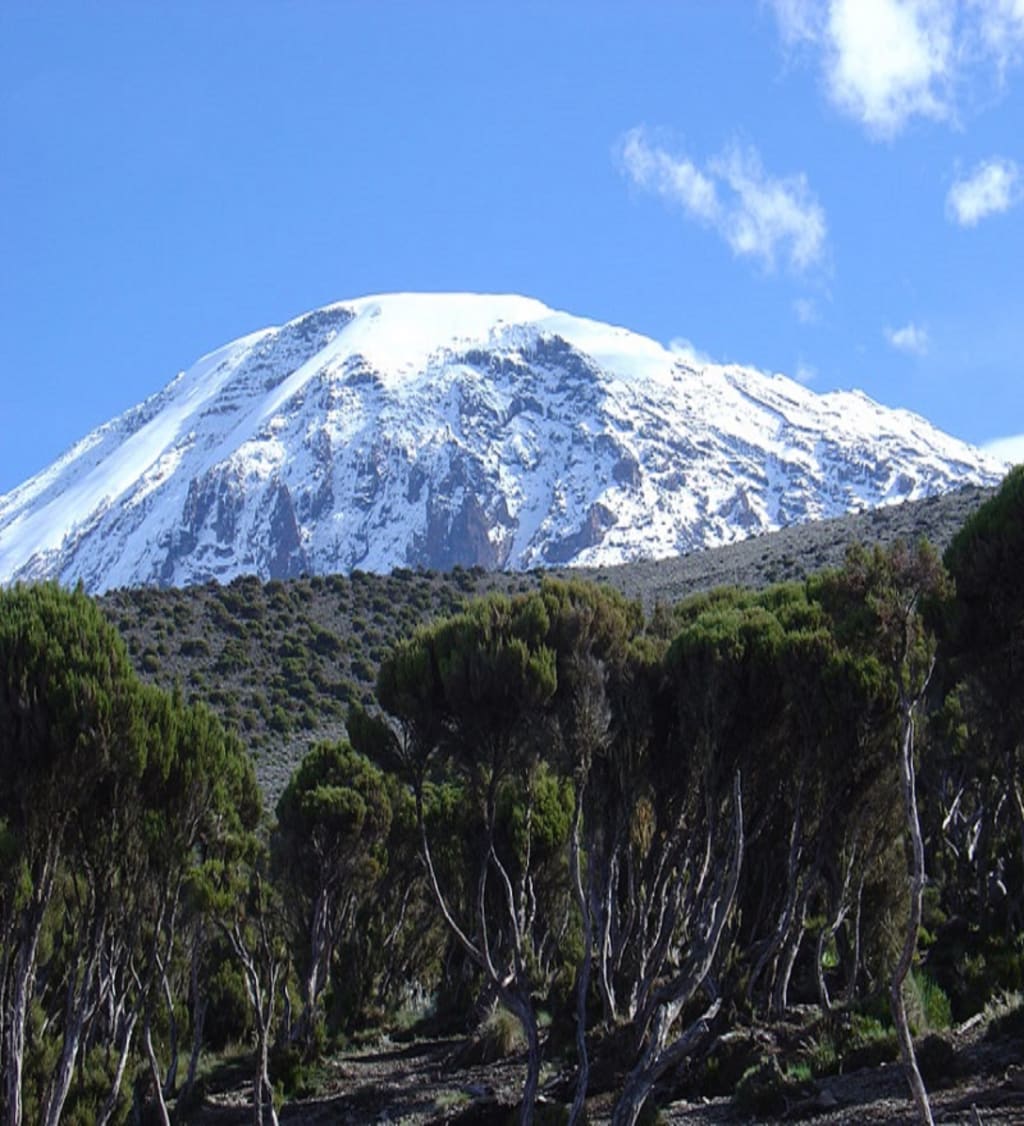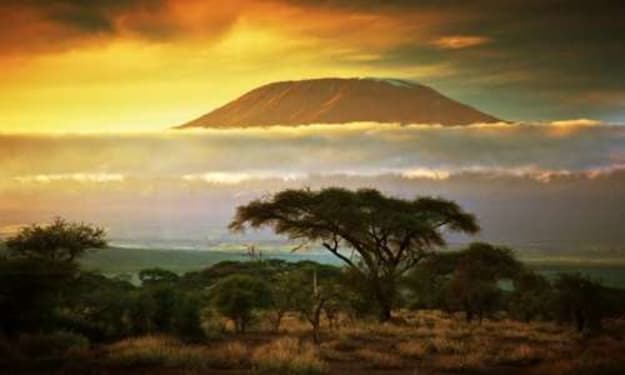7-DAY RONGAI ROUTE FROM KILIMANJARO
7-DAY RONGAI ROUTE FROM KILIMANJARO

7-DAY RONGAI ROUTE FROM KILIMANJARO. Marangu, Machame, Lemosho, Shira, Rongai, and Umbwe are the six recognized routes to climb Mount Kilimanjaro. The south side of the mountain is where the Marangu, Machame, and Umbwe roads all come into play. Approaching from the west are Lemosho and Shira roads. From the north, Rongai Road approaches. Except for Marangu and Rongai, all roads pass via Mweka. On Mount Kilimanjaro, the Rongai path
Rongai is the route to Mount Kilimanjaro.
Due to its distant position, this path is less busy and provides hikers with a unique wilderness experience where they can encounter enormous fauna including antelope, elephants, and buffalo. You'll encounter less rain and have a clearer perspective of the summit because this side of the mountain often has less precipitation. Despite being flatter, it does not provide a high climb option, so extra days should be selected for acclimatization.
One of the more straightforward routes up Kilimanjaro is the Rongai path. The Marangu path is used by Rongai, the only route that ascends Kilimanjaro from the north. The Marangu route from Gilman's Point follows the same route as the overnight summit from Kibo Hut, which is very steep.
Weather on Mount Kilimanjaro Tanzania, due to its proximity to the equator, does not typically experience extreme winter and summer weather, instead having dry and wet seasons. To say the least, the weather on Mount Kilimanjaro can be unpredictable. Precipitation varies from 2100 mm/year in the rainforest zone to less than 120 mm/year in the mountaintop zone. Similarly, daily temperature fluctuations are unusual in comparison to normal weather patterns and are highly altitude dependent.
He is separated into five zones on Kilimanjaro. Coffee and banana fields can be seen on cultivated farmland. A tropical jungle with lovely plants and animals Bogs of heather, rich alpine vegetation, and wildflowers Apparently as a result of volcanic activity, there is a high-altitude desert. a lunar-like desert in the Arctic with glaciers and snowy peaks Each zone has a commensurate drop in precipitation and temperature with elevation starting at around 1,000 m (3,280 ft) elevation. Around 27°C to 32°C (70°F to 80°F) is the typical temperature at the beginning of the ascent, and it stays fairly consistent throughout the year. The temperature drops as you ascend from there. Evening lows at Uhuru Peak's summit range from -18°C to -26°C (0°F to -15°F). As the weather around the planet changes, our seasons become less predictable.
As the world's weather patterns change dramatically, our seasons are becoming less predictable. Rainfall is typically heavier from March to May, and less in November and December. At this time of year, visibility is limited, and the mountains may become more slippery. Summer climbing is ideal from June to October. April and May usually have ideal weather and generally fewer climbers, so you might be lucky enough to have the summit all to yourself. Important information: Our beautiful mountains can stand on their own, and the weather can change at any time! Prepare yourself.
REASONS TO USE THE RONGAI ROUTE The sole route that departs from the northern circuit is Rongai. The route has the best animal visibility because it is undeveloped. Elephants, buffaloes, and huge antelopes can all be seen. The Rongai route has a high success rate, minimizes effort wastage, and presents less altitude issues. It is flatter than other Kilimanjaro routes, allowing you to spend more time in the mountains and sleep on the ground. Both the 6-day and 7-day Rongai routes can be taken to hike it. It is strongly advised that you take the 7-day Rongai route because it will allow you more time to adjust to the appropriate climate.
The Rongai route is exactly 76 kilometers long from gate to gate. Here are the distance travelled days based on the 7-day itinerary.
Day 1: 8 km - The trek begins at Nalemuru Gate and continues into the rainforest.
Day 2: Distance 16 km - Traversing into the low alpine moorland zone where you will notice the vegetation change to shrubs and grasses.
Day 3: 3 km hike from Kikelelwa Camp to Mawenzi Tarn Camp.
Day 4: Acclimatization day (distance 0 km).
Day 5: 9 km - A gradual hike west from Mawenzi Tarn Camp through the saddle.
Day 6: Distance 21 km - This day begins at midnight with an ascent up a rocky path.
Day 7: 19 miles The final day from Horombo Camp to Marangu Gate is nearly 20 kilometers long.
HOW DIFFICULT IS RONGAI ROUTE Although the Rongai route is relatively challenging, it is also very highly advised, especially for travelers. As it begins on the northern side of the mountain, the Rongai path will travel through an area with a significant concentration of species. The Rongai Route 7 Days plan will provide you an extra day for acclimatization as well as more time in the mountains and more opportunities to sleep at lower levels. This aids in preventing altitude sickness. The Rongai path is less congested and lets you take in the scenery on your own
THE BEST TIME TO TAKE THE RONGAI ROUTE ROUTE July-September are the best months to climb Kilimanjaro because the weather is most stable and rain is less likely. However, due to its proximity to the equator, the mountain can be climbed at any time of year. April and May are rainy months, so stay away from them. Because the Rongai Route is on the northern side of Kilimanjaro and is in a rain shadow, May and November are also good months to do the trek.
Is Kilimanjaro's Rongai path the simplest route? The Rongai trail is thought to be the simplest way to ascend Mount Kilimanjaro. The pace of the bike was steady and slow. The Machame or Lemosho routes are thought to be more difficult than the Rongai route since they have a high, low sleep profile. It is strongly advised to choose the 7-day hike option because it allows for better acclimatization. No climbing experience is necessary, however some level of physical fitness is recommended. To further prepare, read our page on our Kilimanjaro training program and other articles about climbing Kilimanjaro.
About the Creator
Enjoyed the story? Support the Creator.
Subscribe for free to receive all their stories in your feed. You could also pledge your support or give them a one-off tip, letting them know you appreciate their work.





Comments
There are no comments for this story
Be the first to respond and start the conversation.